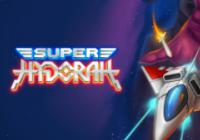Super Hydorah (PC) Review
By TJ  23.12.2018
23.12.2018

Super Hydorah is a challenging shoot'em up in which the player assumes the identity of the best pilot in the galaxy. Single-handedly, you must fight off an entire army of evil bio-mechanical creatures hell-bent on totalitarian control. The path is nonlinear, as multiple forks are present from level to level, with each one offering a new environment and obstacles. Complete with different weaponry that can be used to customise the ship's fighting capability, this pilot is more than ready to cut through the battalions of enemies laying in wait.
Shmups are conceptually somewhat simple, and as such there aren't as many moving parts to balance in order to create a good game. There are, however, three main principles that need to be met: precise controls, exact hitboxes, and engaging levels. While other aspects of this genre are important, none are as imperative as these three. Precise controls means that not only is the ship responsive, but it also moves in a way that doesn't feel too light or too heavy - it can be easily steered around projectiles and dangers in a predictable manner. Exact hitboxes directly correlate with what is seen on screen. If a laser looks a certain width, it should never deal damage outside of itself.
This takes away the unpredictability, and makes failure a product of the player's skill level, and not misleading visuals. The final key principle, engaging levels, is tied less with the core of the gameplay, and more with the replayability and enjoyment of the entire game, rather than the first chunk. This can be surmised as variety in: enemies, levels, scenery, music, arsenal, mechanics, pacing, etc. Super Hydorah feels great to play, on both controllers and keyboard. The movement feels 1:1, without any undue delay between moving and stopping. Finally, controls can be remapped, so if cursor keys aren't favoured, then WASD is a quick tweak away.

Outside of controls, the ship hitbox is accurate to what is seen, and there have been many close calls with either bullets or platforms that proved how exact it is. So while the huge array of bullets, lasers, and space debris hurtling through space might look impossible to traverse, success can be found through careful navigation. Where Super Hydorah shines is in how much variety the campaign has, leading to its replayability as well.
In terms of weaponry, there are three types of weapons available: primary, secondary, and special. Primary is the one that is fired on command, while the secondary one is passive, and can be considered a supplement to the main weapon. The special weapon is incredibly powerful, and is most effective against bosses. When used properly, it can take off upwards of 80% of a boss' life. More weapons can be earned by beating certain bosses. The rewards are predetermined; not random. This means that
strategically doing certain stages first can make future levels easier based on what tools the player has access to.

The overworld is nearly the same as how Star Fox 64 did it, with several branching paths that are up to the player to decide on. All of the levels are unique, and have new enemies and obstacles to deal with, including: spike traps, asteroid fields, vines, destroyed ships, laser beams, etc. Outside of actual combat, there are power-ups that can be collected throughout a level. There are two main types: weapon upgrades, as well as a special power-up. Certain enemies will drop little green and red orbs. These correspond to primary and secondary weapons, and collecting enough of them will make them more powerful.
The special power-up is actually a three in one; it can either be a shield, a continue, or ammunition for the special attack. The shield absorbs one attack that would otherwise be fatal. The continue allows the player to keep trying on the level without ruining their score. The extra special attack will be dependent on what weapon is chosen, but is typically worth having. Suppose that a shield drops, but the player already has one equipped. It doesn't stack, so instead of wasting it, simply wait.
The upgrades will alternate between shield, continue, and special, and this creates a very interesting mechanic. Is it better to have the special attack available for the next boss, or a shield just to be safe? Will a continue be better for the run on a whole, in order to achieve a high score? Some players might forgo a shield entirely in order to destroy bosses faster with special attacks, whereas some might be struggling and need shields every time.

One of the biggest draws to Super Hydorah can be found in its difficulty. While it challenges the player to be better, there are a few punishing aspects that can feel quite demoralising. Upon death, the player has a handful of lives. Once this runs out, then it is game over. The player can still continue, but must relinquish their score, and oftentimes, on a particularly difficult level, it's not uncommon to be sitting at zero points.
To compound this issue, the inherent upgrades to the primary and secondary are reduced upon death. On a boss fight, this means that the second and third attempts are just more difficult, and it can devastate a run entirely. It isn't the end of the world, but it comes off as a campaign that will only get better the more someone plays, and that includes plenty of failed runs and trial-and-error attempts. It leads to plenty of replayability, but at the cost of the experience getting somewhat frustrating.

Cubed3 Rating
Great - Silver Award

Super Hydorah does a lot of things right, and is a great homage to the classic shoot 'em ups. There is a constant push to be better, whether that is to get a new high score, speedrun the campaign, or perhaps to finish without using continues, and the replayability comes from the arcade experience. While the challenge might not be for everyone, friend decreases it, and the nostalgia and modern polish make it worth the struggle.
Comments
Comments are currently disabled

 Sign In
Sign In Game Details
Game Details
 None
None  Out now
Out now  None
None  None
None  Subscribe to this topic
Subscribe to this topic Features
Features






 Top
Top

